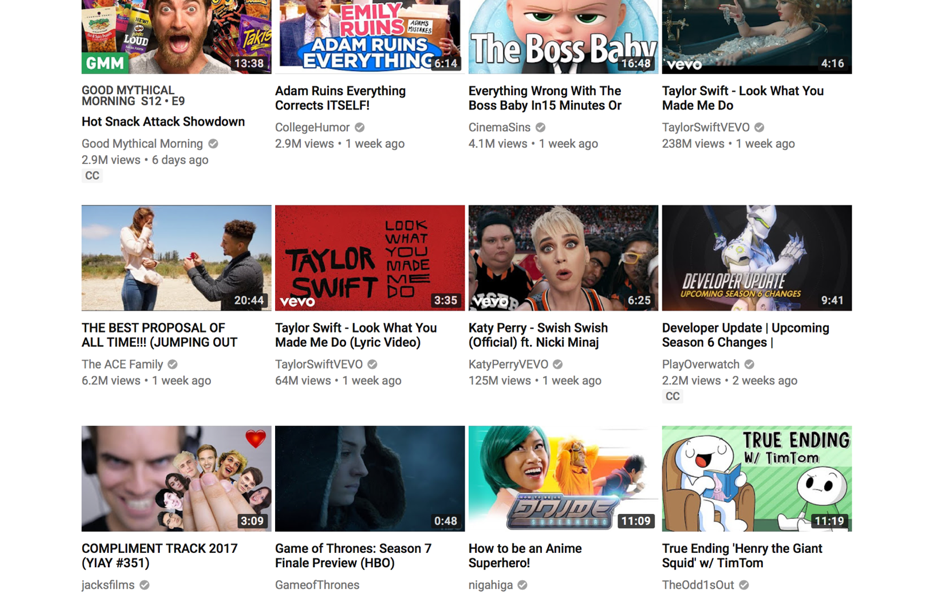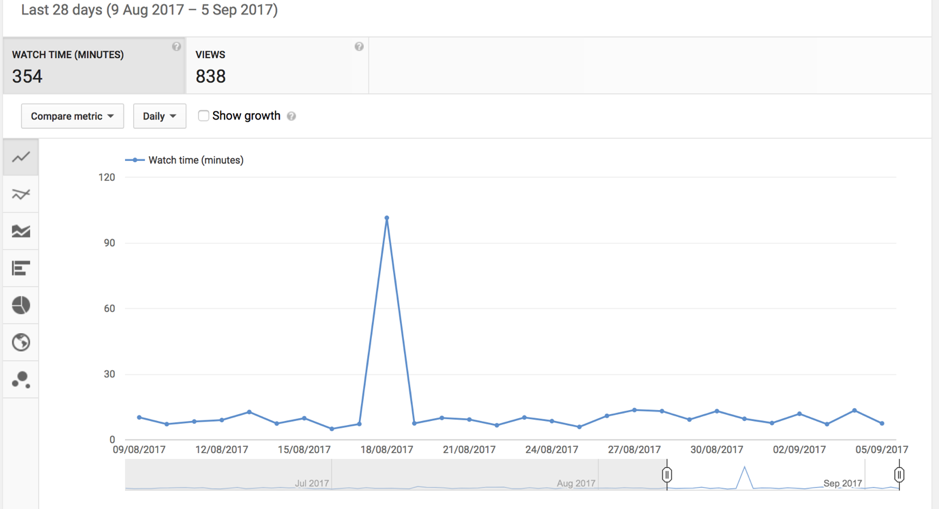“Within the next 5 years Facebook could be All Video.” That was the spine-tingling battle cry echoing throughout the digital marketing world. It was commented last year by Nicola Mendelsohn, the Vice President of EMEA Facebook – to some, the most prominent digital soothsayer within the British digital marketing sphere. Whether it’s true, or the intention behind this was genuine, this sort of trickle of information is something marketers scramble to dissect. The general insight that we can gain from it is that video is big, but it’s going to be even bigger – like super-massive. With this in mind, let’s take a look at the current state of play showing all the tools at your disposal.
What Video Content Works?
Over a 100 years ago an Englishman by the name of Eadweard Muybridge was one of the first ever people to truly capture motion and did so by sequencing a series of shots of a galloping horse. Why did he do this? To answer a burgeoning question: during a horse’s gallop at any point does all its feet leave the ground?
What does this reference to a Victorian stop-motion pioneer (who shot and killed his wife’s lover) have to do with video marketing? Well…
Content needs to have a purpose – and it needs to have meaning.
Even if you’ve spent a grotesque amount of your marketing budget on creating fantastic looking content, if it does not serve a need from the consumer then it’s going to be seen by as many as Blackbeard’s treasure.
Gaining insight into what types of content is working and what’s popular is worth finding out. Look at what attracts the most search volume at any given moment, but also pay some cold hard attention to the sort of content being presented to you. For example:
I’m not too sure about ‘How to be an Anime Superhero’, but you get a general gist of what’s being watched and who the general audience is – which we’ll come to shortly.
If you’re creating an informative piece, emphasize the type of person or presenter who might lead to more shares of the video. A more neutral character is more likely to get shared more – this is similar to how vloggers look to create their content.
Instructional videos gain a lot of views. This is due to bringing in traffic via search engines within a particular niche. Users can then see the volume of what’s been viewed and how many likes the video has, which helps to validate the video in the viewer’s mind.
Look at the words or language used in the titles: words like ‘best’, ‘everything’, ’how to’, ‘all time’. This sends almost primal signals to the user that this is definitive
The first couple of seconds of your video is the most crucial element. This is where the viewer decides to fully commit to watching it in its entirety. Don’t waste their time by spending the first part with a fancy animation of your logo – the user is simply going to turn off. In fact, from our own research, we’ve noticed a 25% drop in views for videos that start with a logo.
I can’t emphasize enough about quality being a major part of your video content. ‘Corporate video is often given a bad reputation. It conjures up images of extreme close-ups of customer testimonials, with the faux leather sofa in tow, or hard-hatted near-retirees pointing at labyrinthine machinery. Think about how to make your content appear natural because that’s what glues our eyeballs to our devices. We’re able to emphasize and feel as if we’re being taken on a journey. This is especially important if you’re a B2C setup.
Another key aspect of your video content is actually how it’s structured. With video, you need to be telling a story, and a story traditionally has three acts that you might want to follow:
1.The Setup
Set the tone and establish your narration. For example, focus your audience comfortably on who’s telling the story or where the video is set. Outline a challenge that your company has faced.
2.Confrontation
Show your audience how you tackled the challenge, all the pitfalls, and how your workforce developed new skills in the process.
3.Resolution
The payoff. This is what the whole video has been building up to, the best place to tie everything up in a neat package and show off your best qualities. And let’s face it, if your viewer has come through this far, they’ve more or less invested themselves in the video, so it’s peak time for a return on their investment.
What are the benefits of Video?
One of the less obvious benefits of creating video content is Time. The ratio of information you can get across in a short time is much larger than, say, that 7,000-word whitepaper.
Video is then by its sheer growth the true future usurper of content marketing. We need to be looking at some of the key developments over the last year, such as:
- 360 videos
- Live streaming
- Interactive Video Platforms
- Virtual Reality
Being on the cutting-edge is becoming less expensive. Depending on your type of business any of the above may suit a particular aspect of your company. There’s no need to feel that you do not have access to any of these capabilities, as most of them can be easily developed.
The Right Platform for the Right Audience
We had a quick peek last year at which video hosting platforms are right for your business. So I’m not going to retread on anything there, but obviously, the most popular destination for video online is Google’s mega-behemoth YouTube, it has by far the biggest reach with 1.5 billion users per month.
Facebook video has gained enormous pace in becoming online video champions, with expansion into 360 videos and Facebook Live.
Snapchat video may have the appearance of being pubescent, but if you’re targeting a younger audience this might be an easy-win.
Instagram is also a great way to show off short content with features like Boomerang.
Vimeo might be right for your business if you produced a visually high-quality video (1080p to 4k) and you don’t want to lose any of that to compression. It may be a good option if you’re B2B company that is not really interested in visibility, but only want to show off to a certain few with a high-quality offering.
If you’d rather bypass all the external hosts, take a look at Wistia. This allows you to self-host any video that you’ve produced, and also benefits from getting a better control of your SEO. Unfortunately, unlike the others, it does cost money – not very Web 2.0.
Whichever platform you choose, make sure you make the content bespoke. Do not duplicate – diversify. What works on Vimeo won’t work on Instagram and vice versa. Plus you also want to all your traffic to be funnelled into one place.
Optimizing Your Video for the Web
When it comes to adding that extra layer of visibility, don’t miss out on optimizing its appearance. Let’s take a look at YouTube, as it’s the second most used search engine on the web and should be treated as such. Search engines crawl these pages like anything else so there are some key SEO points:
- Adding captions is an absolute must, not only from the perspective that Google gives preferential treatment, but it’s excellent for being user-friendly as more people are watching on their mobile devices – possibly in a public space where sound is not an option.
- Treat the description as you would any piece on your site. Create original content, don’t be afraid of a high word count (in fact, the higher, the better). Make sure to put any CTAs in there too, or else your product will be hard to find.
- Do not forget your channel page. Literally, write the grandest articulation about your company under the about tab and don’t forget links!
- Look for keywords that attract big search volumes when it comes anything you’re posting including the title.
- Create an awesomely attractive banner for your channel page. An easy tool you can use to do this is Canva.
You can also get some great stats in Google Analytics if you embed your video within the desired page on your website. You’ll see dwell time becoming higher, especially if there’s not a lot of text.
Video tags, unlike the defunct meta tags, actually have some benefit. They do appear to help YouTube get to grips with what your content is actually about, and if you share a certain keyword with another video, you’re more than likely to pop up as a related video.
If you have the option, depending on what platform you’re using, customize video thumbnails with branding. When shared via other platforms you’ll boost your imagery. But try to keep it minimal – don’t over-stuff it. This is also an opportunity to put in your most appealing shot – think of it as the film poster to your content.
With Facebook, you’ll be able to gather your data through Facebook Insights. The important metrics you’ll need to track is duration and completion rates.
Do not link to YouTube in a Facebook post. It doesn’t look pretty and Facebook is generally biased towards its own video hosting service. It pretty much doesn’t like you leaving the social media site.
There’s also some argument in using YouTube like you would a social media platform, interacting with other content, creating playlists and so on. But the benefit of this would be at your business’s own insight and discretion.
There are also various other ways to optimize video content across other platforms, such as Twitter or Instagram, where it’s recommended to use between 10-15 hashtags to really get full exposure.
Measuring Your Success and others
Like your rankings in the search engine results page, the data in your video analytics is a crucial part of seeing what works – like the number of sessions. The number of views you receive is not what makes your video a success, it’s actually the retention of your audience. If your total viewers are only watching a few seconds you wouldn’t call that great content.
Other metrics to keep an eye on are on any particular video is the comments to views ratio and the views per subscription.
Use free browser extensions such as VidIQ or Socialblade to research your competitors. See what content works for them but also look at what tags they’re using for their videos to help boost their visibility.
There’s a lot more with video and we haven’t even skimmed the surface with targeting demographics or paid ads. But before we get into that it’s worth having a try and just create content.
Vacuum up all the above information, take a look around your company, note any opportunities worth punctuating through the visual medium. More importantly, find your own ‘flying horse’. (If you’ve skipped to this sentence I appreciate that this makes no sense at all.)


